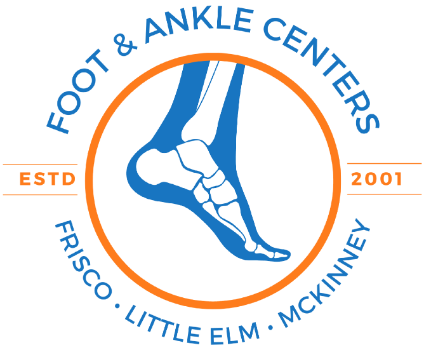Hyperhidrosis & Excessive Sweating Care | Foot & Ankle Centers
Tuesday, August 12, 2025 | By: Foot & Ankle Centers of Frisco, Little Elm, McKinney
Hyperhidrosis is a condition causing excessive sweating beyond what’s needed to regulate body temperature. It can affect the hands, feet, underarms, and face, leading to social anxiety, discomfort, and challenges in daily life. Approximately 3% of the population suffers from this condition. In this comprehensive guide, we’ll explore the causes, impact, and management strategies to help you regain control and confidence.
The Basics of Hyperhidrosis
Hyperhidrosis is categorized into two main types: primary and secondary.
1. Primary Hyperhidrosis: This type involves excessive sweating in specific areas, such as palms, feet, armpits, and the face, without any underlying medical condition. It often starts in childhood or adolescence and can be inherited. People with primary hyperhidrosis might sweat excessively at rest or during normal activities.
2. Secondary Hyperhidrosis: This type is associated with an underlying medical condition or is caused by certain medications. Sweating occurs over larger areas of the body and can occur at any time, regardless of activity level. Some common causes include hormonal disorders (like hyperthyroidism), diabetes, infections, and even specific cancers.
Understanding the Causes
The exact cause of primary hyperhidrosis is still unclear, but it is believed to involve abnormal functioning of the sympathetic nervous system, which is responsible for initiating sweating. Factors such as family history may contribute, meaning genetics could play a role in the development of the condition.
Secondary hyperhidrosis can be triggered by various factors:
- Medications: Certain medications like antidepressants, painkillers, and supplements can induce excessive sweating.
- Health Conditions: Health issues like diabetes, hyperthyroidism, menopause, and obesity can lead to sweating episodes, rounding back to a more ubiquitous form of sweating.
- Allergies and Infections: Some allergic reactions and infections can make you sweat more.
Psychological Impact
Hyperhidrosis is not just a physical condition; it can also significantly affect one’s psychological well-being. Those who experience hyperhidrosis often report feelings of embarrassment and anxiety. This can lead to social withdrawal, affecting both personal and professional relationships. The psychological stress caused by excessive sweating can make everyday activities, like shaking hands or holding a pen, challenging.
Furthermore, individuals may find themselves avoiding situations where they believe their sweating will draw attention, leading to isolation and decreased quality of life. This underscores the importance of not just treating the sweating but addressing the emotional impacts as well.
Diagnosis of Hyperhidrosis
If you suspect you have hyperhidrosis, it’s essential to consult a healthcare provider, such as those at Foot & Ankle Centers, for a proper diagnosis. During the appointment, a doctor will typically:
- Conduct a comprehensive medical history review.
- Use the Minor’s starch-iodine test, where a solution is applied to skin areas to visualize sweat production.
- Evaluate your family history to determine the possibility of genetic factors.
- Consider additional tests if secondary hyperhidrosis is suspected, looking into various health conditions or medications.
Treatment Options
Several treatment roads can be taken for managing hyperhidrosis:
1. Over-the-Counter Antiperspirants
Many people find success using a stronger, over-the-counter antiperspirant that contains aluminum chloride hexahydrate. Look for clinical strength products designed for excessive sweating.
2. Prescription Antiperspirants
If over-the-counter options don’t provide relief, doctors may prescribe a topical antiperspirant with higher concentrations of aluminum chloride that can block sweat glands more effectively.
3. Botox Injections
Botox, known for its wrinkle-reducing properties, is also FDA-approved for treating hyperhidrosis. The process involves multiple small injections in the affected area. Botox temporarily blocks the nerves that cause sweating, providing relief for several months before further treatment is needed.
4. Iontophoresis
This non-invasive treatment involves placing the hands and/or feet in a device that delivers a mild electrical current. Patients often require multiple sessions to see results; however, the treatment can be effective for localized sweating.
5. Medications
Oral medications, such as anticholinergics, can help reduce sweating by blocking the chemical signals responsible for activating sweat glands. However, potential side effects need to be considered.
6. Microwave Therapy
This procedure uses microwave energy to destroy sweat glands in the underarms. It is a minimally invasive option that can provide lasting results.
7. Surgical Options
For severe cases of hyperhidrosis, surgical removal of sweat glands may be an option. Other procedures, such as sympathectomy, which involves cutting nerves that trigger sweating, can also be considered—namely for people suffering from severe palmar hyperhidrosis.
Lifestyle Changes and Management
Regardless of treatment method, there are several ways to manage hyperhidrosis in your daily life:
- Wear Loose, Moisture-Wicking Clothing: This can help minimize discomfort by allowing sweat to evaporate easily.
- Stay Hydrated: Drinking water can help regulate body temperature, potentially reducing excessive sweating episodes.
- Practice Relaxation Techniques: Stress and anxiety can worsen sweating symptoms. Techniques like yoga, meditation, or deep-breathing exercises may help combat stress.
- Choose Fabrics Carefully: Cotton and other breathable fabrics can help keep you cooler than synthetics.
- Create a Cool Environment: Staying in air-conditioned rooms and using fans can help keep your body temperature in check.
Embracing Life Beyond Hyperhidrosis
Living with hyperhidrosis can be challenging, but understanding and addressing the condition can transform your quality of life. Whether through medical interventions, lifestyle changes, or psychological support, a path exists towards managing and reducing the symptoms of hyperhidrosis.
If you or someone you know is struggling with excessive sweating and its emotional impacts, seeking guidance can be life-changing. Dr. Knapp, Dr. Tavakoli, and Dr. Treleven at Foot & Ankle Centers—serving Frisco, Little Elm, and McKinney—specialize in helping patients understand hyperhidrosis and provide effective and personalized treatment solutions. It’s essential to remember that you are not alone in this journey—resources and solutions are ready to be embraced.


Leave a comment
0 Comments